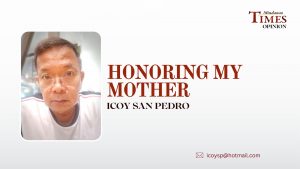DXAW and DXMC were the local radio stations when Davao was still one big, solid, undivided province, lush with pristine forests and as far-as-you-can-see immense timberstand that beckoned the daring and adventurous to trailblaze the logging industry. 30 years after men and heavy equipment combed the forests of Davao, the rich timberland were unmercifully denuded, exposing bare earth to heavy rains, causing deadly floods and cascading landslides, killing people and wildlife.
Television was unknown until the late 60s so in the 50s, Davao folks were just plain avid radio listeners. Tuning in to their daily repertoire of breaking news, music, drama and entertainment segments were a daily ritual one cannot do without. Political ads by candidates, political parties, satires and harsh commentaries drew in revenues and kept the till awash with cash, keeping afloat the operations. When elections drew near and the campaign started to percolate, commentaries became highly vitriolic and scurrilous. All these fed to the insatiable appetite of partisan politics.
DXAW had its studio in Apo View Hotel where radio broadcasters Pat Dugan, Larry Orbeta, Nonoy Morada and Ruding Cutler became exponents of the premiere radio company’s memorable slogan: “The station most people listen to most.” A live variety show “Saturday Roll Call” featured the Viscounts singing group doing rock and toll music of the late 50s. Students and youngsters were the usual crowd that filled up the studio, riveted by the music of Papin and Teddy Ventura, Vic Luna, Marte Lascano and Nonoy Morada.
DXMC had similar exciting repertoire bringing to the listeners news coverage, drama, entertainment and commentaries, keeping in step with the city’s urban growth and sophistication. Mike Balbin’s mellifluous voice in news casting and commentaries mesmerized listeners. Zach Solon kept in touch with the masses with his comical satires on politicians and government officials. The jokes became hot topics of conversation which spurred the station’s socio-political dimension. All told, radio broadcasting was the great communicator and medium that served the Davaweños and enriched their social and political maturity. Evidently, It mirrored the idiosyncrasies of the city.
Iconic San Pedro St had three popular movie houses: Gem’s, Liberty and Universal theatres. (Golden and Crest burst into the scene in the mid 60s after the 1964 San Pedro-Magallanes fire). Also, Garmon and Galaxy along Ilustre St. followed in the late 60s surge of moviehouses. Lyric theatre along Anda St was one memorable movie house that featured the biggest movie attraction of the decade, The Ten Commandments. Due to its all time demand, the classic movie ran for several weeks, watched by several thousands of city residents as well as those from far flung towns of the province. Hard to believe how folks in those days can watch movies inside an asphyxiating non-air con, standing room, smoke-stenched hall.
Unlike most moviehouses, only Liberty, Ideal, Life and Eagle had the distinction of a generously layed-out huge tunnel- like lobby with the main entrance stretched from the sidewalk to the theatre proper. To spike one’s interest, both wings of the foyer hung still photos of the current movie feature and the forthcoming films. Along Bonifacio St. were the decrepit Tagumpay and Clifford. (Queens came along in the early 70s). Claveria St. had Davao Theatre, Ideal, Eagle, and Life. Lawaan joined in the mid 60s. Oyanguren in Santa Ana had Roxy and Avenue theatres while Monteverde St. had Stars. Most moviehouses played double feature programs and patrons need not empty the theatre after the feature film ends. Occasionally a triple feature deal became popular which could nail one to his seat for 5 to 6 gruelling hours.
To be continued


